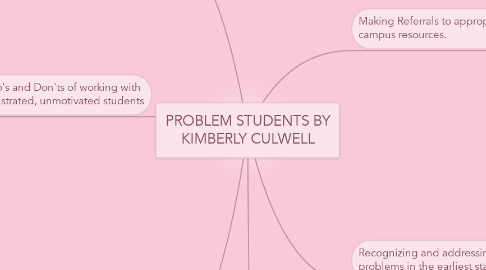PROBLEM STUDENTS BY KIMBERLY CULWELL
par Kim Culwell


1. Appropriate intervention strategies for different styles of behavior
1.1. Teacher models what it means to be a critical thinker when there is opposition.
1.2. Teacher should "demonstrate scholarly debate, including careful listening, thoughtful reflection, respectful disagreement and reasonable compromise, where appropriate" (Svinicki & McKeachie, 2011, p.172).
2. Theory behind working with difficult and unmotivated students
2.1. State class rules/policy and enforce consistently.
2.2. Use controversy as a teaching opportunity to model good critical thinking.
2.3. Keep your temper under control. Don't respond immediately. Keep control of your class.
2.4. Be confident in your knowledge - don't suggest alternatives.
2.5. Problem students are human beings with real problems - who need help and sympathy.
3. Do's and Don'ts of working with frustrated, unmotivated students
3.1. DO'S
3.2. Expand your teaching style to spark interest.
3.3. Encourage your students.
3.4. Provide additional material.
3.5. Refer students to support center.
3.6. Encourage students to work together- set up a support group.
3.7. Focus on individual progress rather than performance in relation to peers.
3.8. Don'ts
3.9. Remind them of previous failures.
3.10. Set unattainable goals.
3.11. Ignore the student when they come to you for help.
4. Recognizing and addressing problems in the earliest stages
4.1. Students who want the truth/everything is relative
4.1.1. Students who are unprepared for course or struggling.
4.1.1.1. Students who are really interested in topic and has prior knowledge.
